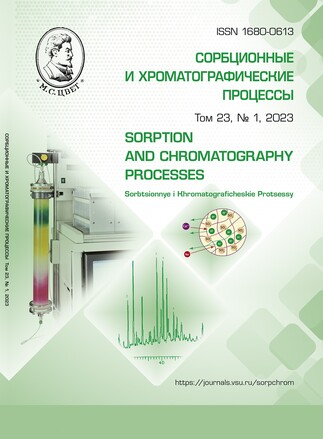Sorption of preservatives by molecularly-imprinted polymers
Abstract
Molecularly imprinted polymers (MIPs) are widely used as sorbents for the separation of substances, as well as in the production of selective sensors. Therefore, it is necessary to study the properties of these polymers for the optimisation of the conditions for the synthesis of MIPs and improvement of the sensory determination of substances. The purpose of this study was the investigation of the ability of molecularly imprinted and non-impregnated (reference polymers) polymers to absorb sodium benzoate and potassium sorbate from aqueous solutions. These materials were synthesized in two stages (I – stage at a temperature of 80oC,
II – stage at 180oC) using a non-covalent imprinting method. Sodium benzoate (E211) and potassium sorbate (E202) were used as templates. Sorption isotherms of preservatives by MIPs and non- imprinted polymers were obtained using direct conductometry. According to the sorption kinetic curves, the time of achieving equilibrium for non-impregnated polymer (reference polymer) and molecularly imprinted polymers MIP-E211 and MIP-E202 was 20-25 min. The shape of the sorption isotherm of sodium benzoate, potassium sorbate is typical for monomolecular adsorption. Sorption of sodium benzoate and potassium sorbate by MIPs is carried out mainly due to the formation of hydrogen bonds between the carboxyl groups of the sorbent and sorbate. Based on the results obtained, the recovery rates (R) were determined, which amounted to more than 30% for the imprinted polymers, as well as the distribution coefficients (D) and the values of the imprinting factor (IF). The imprinting factor for sodium benzoate was 4.8; and for potassium sorbate it was 2.5. In the course of the study, the best sorption capacity of polymers imprinted with sodium benzoate (MIP-E211) and potassium sorbate (MIP-E202) preservatives was established, compared to a non-imprinted polymer, while a polymer with an imprint of sodium benzoate has a greater sorption capacity than a polymer with an imprint of potassium sorbate. Thus, based on the studies performed, the possibility of using molecularly imprinted polymers with imprints of sodium benzoate and potassium sorbate preservatives as a selective coating on the surface of piezosensor electrodes has been established.
Downloads
References
Chen L., Xu S., Li J. Recent advances in molecular imprinting technology: current status, challenges and highlighted applications. Chemical Society Reviews, 2011; 40: 2922-2942. https://doi.org/10.1039/c0cs00084a
BelBruno J.J. Molecularly Imprinted Polymers. Chemical Reviews, 2018; 119: 94-119. https://doi.org/10.1021/acs.chemrev.8b00171
Bizina E.V., Farafonova O.V., Tara-sova N.V., Ermolaeva T.N. Synthesis and application of magnetic molecularly imprinted with tetracycline polymer nanopar-ticles in a piezoelectric sensor. Sorbtsionnye I Khromatograficheskie Protsessy, 2021; 21(2): 177-186. https://doi.org/10.17308/sorpchrom.2021.21/3352 (in Russ.)
Steinem C., Janshoff A. Piezoelectric Sensors. Springer, 2007, 484 p.
Zyablov A.N., Khalzova S.A., Selemenev V.F. Sorption of red food coloring polymers with molecular imprints. Izv. Vyssh. Uchebn. Zaved. Khim. Khim. Tekhnol, 2017; 60(7): 42-47. https://doi.org/10.6060/tcct.2017607.5595 (in Russ.)
Cao Nhat Linh, Zyablov A.N., Duvanova O.V., Selemenev V.F. Sorption of carboxylic acids by molecularly imprinted polymers. Izv. Vyssh. Uchebn. Zaved. Khim. Khim. Tekhnol, 2020; 63(2): 71-76. https://doi.org/10.6060/ivkkt.20206302.6071 (in Russ.).
Zyablov A.N., Duvanova O.V. et al. Patent RF, No 156900, 2015 (in Russ.).
Kudrinskaya V.A., Dmitrienko S.G. Influence of the solvent on the sorption properties of polymers with molecular im-prints of quercetin. Sorbtsionnye i khromatograficheskie protsessy, 2009; 9(6): 824-829. (In Russ.)
Khalzova S.A., Zyablov A.N., Duvanova O.V., Selemenev V.F., Kozlov A.T. Sorption of synthetic dyes polymers with molecular imprints. Sorbtsionnye I Khromatograficheskie Protsessy, 2017; 17(1); 156-160. https://doi.org/10.17308/sorpchrom.2017.17/365 (in Russ.)
Netskina O.V. Adsorbtsiya iz rastvorov na tvordoy poverkhnosti. Novo-sibirsk : RITS NGU, 2015, 17 p. (in Russ.).







